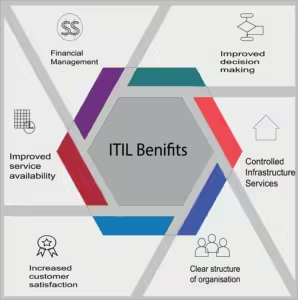Managing and optimizing IT services is paramount for any organization in our increasingly digital world. The Information Technology Infrastructure Library, widely known as ITIL, is the gold standard for ensuring quality and efficiency in IT service management.
This guide illuminates the path for guiding clients through ITIL implementation and provides an extensive understanding of this framework.
What is ITIL?
ITIL is a set of practices for IT service management (ITSM) that aims to align IT services with businesses’ needs. With a focus on delivering value, it’s a framework that helps organizations enhance their IT services and streamline their processes.
The Importance of ITIL
Implementing ITIL can offer numerous benefits, such as:
- Improved Service Delivery: Ensures that IT services align with business requirements.
- Better Customer Satisfaction: Provides high-quality service delivery that enhances user satisfaction.
- Cost Management: Helps manage resources more effectively, reducing waste and unnecessary expenditure.
- Operational Efficiency: Streamlines IT operations, leading to increased productivity.
Phases of ITIL Implementation
Successfully implementing ITIL involves a structured approach which can be broken down into five major phases:
1. Service Strategy
This phase forms the foundation of the ITIL framework. It emphasizes identifying the customer’s needs and developing IT services that align with the business strategy.
- Define Services: Work with clients to define their service offerings clearly.
- Evaluate Current Capabilities: Assess the current IT capabilities and how they support business strategies.
- Identify Business Outcomes: Align IT objectives with business goals and outcomes.
2. Service Design
Service Design is about designing new IT services or modifying existing ones to achieve the desired quality levels.
- Service Catalogue: Develop a comprehensive service catalog listing all IT services and their details.
- Service Level Management: Establish clear service level agreements (SLAs) that set expectations for service delivery.
- Capacity Management: Ensure IT resources are adequate to meet current and future demands.
3. Service Transition
Once services have been designed, the focus shifts to transitioning these services from development into the live environment without disruption.
- Change Management: Implement change management processes to effectively manage the IT change lifecycle.
- Release and Deployment: Plan and execute deploying new or changed services.
- Configuration Management: Maintain information about the configuration of IT services and infrastructure.
4. Service Operation
This phase focuses on delivering and managing IT services effectively and efficiently.
- Incident Management: Establish processes to respond promptly to service interruptions and restore normal service operations.
- Problem Management: Identify and manage the root causes of incidents to prevent recurrence.
- Access Management: Ensure authorized users can access services while preventing unauthorized access.
5. Continuous Service Improvement
Continuous Service Improvement (CSI) is an ongoing phase aimed at constantly enhancing the efficiency and effectiveness of IT services.
- Measure Performance: Use key performance indicators (KPIs) to measure the performance of IT services.
- Identify Improvements: Regularly review and identify areas for improvement.
- Implement Changes: Implement the necessary changes and continuously monitor their impact.
Key Considerations for Successful ITIL Implementation
Understand Your Client’s Needs
Before implementing ITIL, it is crucial to thoroughly understand your client’s business needs and objectives. This understanding will guide every step of the implementation process.
Engage Stakeholders
Ensure all relevant stakeholders are engaged and on board with the ITIL implementation. This includes IT staff, business leaders, and end-users.
Training and Education
Invest in training and educating your staff about ITIL principles and practices. Certification programs for ITIL Foundation, Practitioner, and Intermediate levels can be immensely beneficial.
Adapt ITIL to Your Environment
ITIL is not a one-size-fits-all framework. Adapt its principles and practices to suit your client’s organization’s specific needs and circumstances.
Tools and Technology
Leverage ITIL-compliant tools and technologies to streamline processes and enhance efficiency. Many tools offer functionalities that support ITIL practices, such as incident management, change management, and configuration management.
Conclusion
Implementing ITIL can significantly enhance IT services’ efficiency, reliability, and quality, ultimately driving better business outcomes. By guiding your clients through the structured phases of ITIL implementation—Service Strategy, Service Design, Service Transition, Service Operation, and Continuous Service Improvement—you can help them achieve their business objectives with higher service quality and fewer disruptions.
Remember, successful ITIL implementation is a continuous journey of improvement and adaptation. It ensures that IT services always meet evolving business needs and drive organizational success.

